Banksia proteoides, commonly known as king dryandra, is a shrub endemic to Western Australia. It was known as Dryandra proteoides until 2007, when all Dryandra species were transferred to Banksia by Austin Mast and Kevin Thiele.

Cryptandra is a genus of shrub in the plant family Rhamnaceae.

Grevillea flexuosa, commonly known as zigzag grevillea or tangled grevillea, is an endangered shrub endemic to Western Australia.
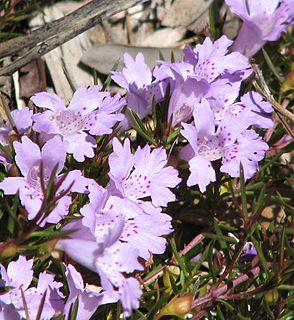
Hemiandra pungens, commonly known as snakebush, is a shrub or trailing plant that is endemic to southwestern Western Australia.

Calocephalus is a genus of flowering plants in the aster family, Asteraceae. It is endemic to Australia, where it is represented in every state.
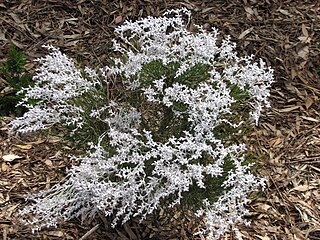
Conospermum stoechadis, commonly known as common smokebush, is a shrub endemic to Western Australia.
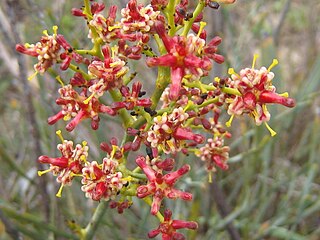
Stirlingia latifolia, commonly known as blueboy, is a plant endemic to Western Australia.

Scholtzia is a genus of flowering plants in the family Myrtaceae, which are endemic to the south-west of Western Australia. The genus was first described by Schauer in 1843, who named it in honour of the physician Heinrich Scholtz.
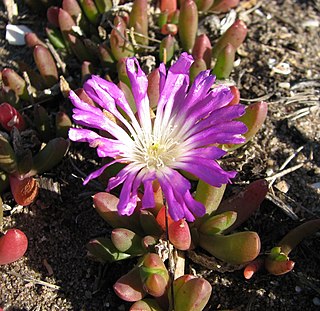
Disphyma is a monotypic genus of succulent shrubs. Commonly known as round-leaved pigface, New Zealand iceplant and purple dewplant, it occurs in South Africa, Australia and New Zealand. Its sole species, Disphyma crassifolium, is divided into two subspecies, D. crassifolium subsp. crassifolium and D. crassifolium subsp. clavellatum.
Banksia fraseri var. fraseri is a variety of Banksia fraseri. As an autonym, it is defined as encompassing the type material of the species. It was known as Dryandra fraseri var. fraseri until 2007, when Austin Mast and Kevin Thiele sunk all Dryandra into Banksia. As with other members of Banksia ser. Dryandra, it is endemic to the South West Botanical Province of Western Australia.
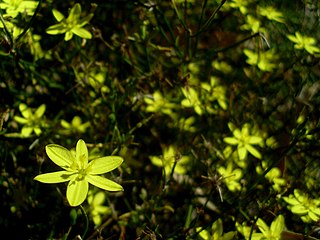
Tricoryne is a genus of perennial herbs in the family Asphodelaceae, subfamily Hemerocallidoideae. All species are native to Australia with two species extending to New Guinea; within Australia they occur in all 6 states and the Northern Territory.
- Tricoryne ancepsR.Br. - New Guinea, Queensland
- Tricoryne corynothecoidesKeighery - Western Australia
- Tricoryne elatiorR.Br. - Yellow Rush-lily - all 6 states plus Northern Territory
- Tricoryne humilisEndl. - Western Australia
- Tricoryne muricataBaker - Queensland
- Tricoryne platypteraRchb.f - New Guinea, Queensland
- Tricoryne simplexR.Br. - New South Wales
- Tricoryne tenellaR.Br. - Mallee Rush-lily - Western Australia, South Australia
Banksia nutans var. nutans is a variety of the plant Banksia nutans. It is native to the Southwest Botanical Province of Western Australia. As an autonym, its name is defined as containing the type specimen of the species.

Banksia sphaerocarpa var. sphaerocarpa is a variety of Banksia sphaerocarpa. It is native to the Southwest Botanical Province of Western Australia. As an autonym, it is defined as containing the type specimen of the species.

Velleia is a genus of herbs in the family Goodeniaceae. Of the 22 species, 21 are endemic to Australia, and one is endemic to New Guinea. The genus was named by James Edward Smith, after Thomas Velley.

Trichodesma zeylanicum, commonly known as camel bush or cattle bush, is a herb or shrub native to Australia.

Chamaescilla corymbosa, commonly known as blue stars, blue squill or mudrurt, is a tuberous perennial herb species in the genus Chamaescilla. It is endemic to southern Australia.
Stemona australiana is a plant species native to tropical south-east Asia, including northern Australia and Papua New Guinea. It grows as a herb or climber up to two metres high.

Andersonia is a genus of small evergreen shrubs in the family Ericaceae. The genus is endemic to the Southwest Botanical Province in Western Australia.
Grevillea parviflora is a shrub species in the family Proteaceae. It is native to the state of New South Wales in Australia. There are two subspecies:
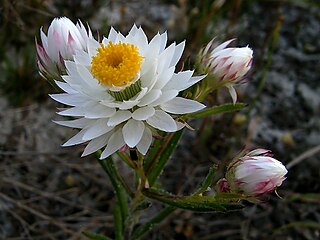
Waitzia suaveolens, commonly known as fragrant waitzia, is an annual herb in the family Asteraceae. It is endemic to the south-west of Western Australia. Plants grows to 0.6 metres in height and flower between September and January.















